Beyond email blasts: 7 customer engagement strategies that actually work
Measuring a community’s success means different things to different community managers. Some measure by the number of members, others by their email open rates. But when we talk to people running thriving communities, one thing about them stands out—they’re locked in on driving customer engagement.
We’re not talking about sending more tired drip email campaigns or introducing yet another new survey tool.
🤝🏼 Modern community engagement is about building a cycle of trust throughout every interaction with (and between) your members.
“Communities that thrive will be the ones with real connection, not just flashy tools or big numbers.”
— Kristen Bousquet, founder of Your Soulcialmate in the 2025 Community Trends Report
You might be thinking, “I don't know. That sounds like a lot of work!”
We get it. But don’t worry, customer engagement isn’t a one-person job.
These thriving communities we’re talking about have brought their members into the mix to help scale engagement. They provide their members with opportunities to lead conversations and events, creating new connections, strengthening existing ones, and attracting potential new members to see what makes this community so engaging.
Member-led customer engagement isn’t only about scale. It’s a strategic approach to enhancing your community and growing your business.
Ready to grow your customer engagement? Good, then come with us on a journey as we look at:
- What we mean by “modern customer engagement”
- How to get marketing and customer service teams on the same page
- The lowdown on 7 strategies to drive engagement and build trust
Customer engagement vs. customer experience
Real talk: I typed “experience” a few times when I meant to type “engagement”. You get it. They sound similar, but they are distinct aspects of building community.
- Customer experience is made up of the interactions your member has with your community. These experiences can include in-person and virtual events, forum discussions, and earning dopamine rewards through community gamification.
- Customer engagement is the strategy and day-to-day tactics to help your members authentically interact with your content and fellow members. Community managers use analytics to track engagement and adjust on the fly to improve it over time.
👉 Customer experience is the venue. Customer engagement is the crowd singing along.
What does modern customer engagement look like?
Customer engagement has moved beyond clicks and campaign reach. Today, customer engagement is centred on fostering genuine participation, trust, and value.
Engagement is the heartbeat in a community-led business. Here are some ways to know customer engagement is working in your community:
- Members welcome each other without needing to be prompted
- Organic conversations start and grow without moderation (having solid community guidelines is a must-have)
- Members refer others because they genuinely love being part of it
- Event RSVPs turn into repeat attendance
- Analytics show consistent participation, not just spikes.
🎤 Think about it this way: a karaoke bar might have 1,000 song choices, but does it have an audience encouraging you to take the mic?
7 proven strategies to drive engagement and build trust
The strongest communities aren’t built on content alone. They’re built on connection. These 7 strategies are designed to help you spark meaningful engagement, earn your members’ trust, and create experiences that keep them coming back.
Whether you’re getting started or looking to level up, Circle gives you the tools to turn casual members into committed contributors.
1. Create an onboarding experience that drives engagement
Onboarding is your first opportunity to let members know this isn’t another newsletter or Facebook Group. They’re joining an intentional community of peers who are here to support, share, and help them grow.
With Circle, you can guide new members from day one using spaces, workflows, AI agents, and tags:
- Spaces: Let you organize your community so members can easily find welcome messages, key resources, and intro threads.
- Workflows: Guide members through your ideal onboarding flow, such as updating their profile, completing a challenge, or posting for the first time.
- Tags: Help you track their progress and personalize the experience based on actions or interests.
- AI agents: Can support with triggered hello’s and next steps in direct messages, introductions, and support questions on their journey.
Here's an example of a pop-up that communities can use to guide new members directly towards engagement.
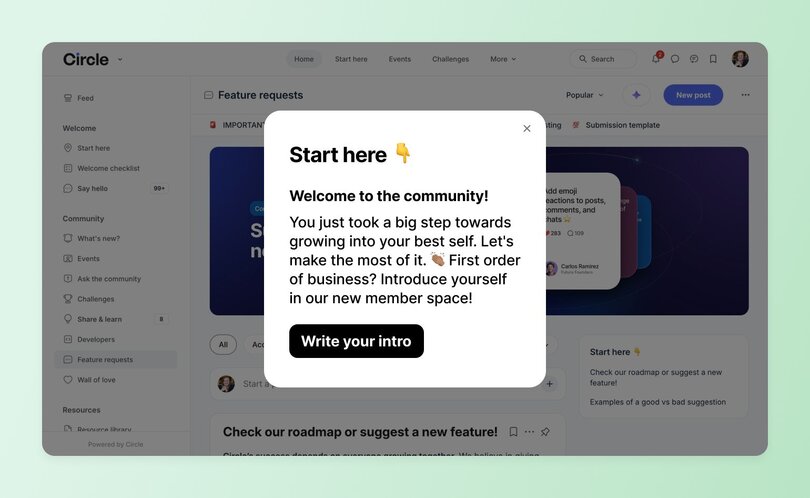
Together, these tools turn onboarding into a meaningful first touchpoint that builds momentum.
2. Create rituals that keep members coming back
Predictability doesn’t mean you have to be boring. Creating rituals around member touchpoints can build a strong sense of belonging that drives customer engagement.
Ritualized touchpoints (which just sounds cool) include:
- Regular email updates with summaries of activity in your community (Circle can automate these for you!), upcoming events, and new member offers.
- Birthday or anniversary messages to make your members feel seen and appreciated. They also give your other members an opportunity to engage with comments and birthday cake emojis.
- Set office hours or member circles give your members a consistent way to connect, share their experiences, and ask questions.
For example, neuroscientist and community builder Anne-Laure Le Cunff runs weekly coworking meetings and review & planning meetings in her experimentation-focused community Ness Labs.

🏠 When members know what to expect (and look forward to it), that’s when a community starts to feel like home.
3. Meet your members where they are in their journey
Not every member needs the same nudge. Some may be just starting out and need a friendly hello. Others might be raving to co-host your next event. The risk is that by treating them the same, you end up disengaging both.
With Circle, you can segment your members based on behavior, activity, and milestones using tags, journeys, and segment-specific content. This means you can:
- Send re-engagement campaigns to lurkers who haven’t posted in a while—using Circle’s Activity Score.
- Invite active members into exclusive content, events, or leadership roles.
- Tailor your onboarding or learning paths to fit where someone actually is, not where you hope they’ll be.
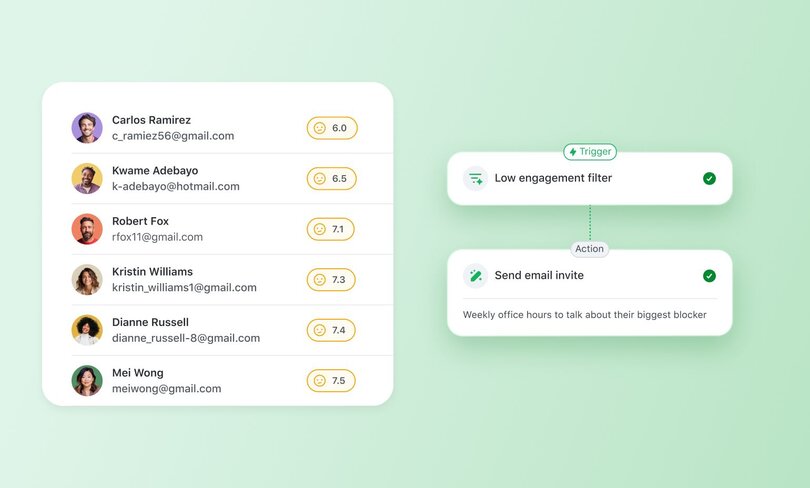
🎯 When you meet people where they are, you’re building trust and driving long-term engagement by design.
4. Feedback loops with a purpose
Good communities listen. Great communities act.
Gathering feedback does more than give you insights on how to improve your community. It can help you create meaningful opportunities for members to shape what comes next.
With Circle, you can collect real-time insight and use that input to refine your content, test new ideas, or even guide product decisions. You can collect insights through:
- Polls: Quickly gauge interest, preferences, or sentiment on a specific topic with a single click.
- Discussion threads: Create space for deeper conversations where members can share personal experiences, vote with replies or reactions, and surface themes you might not have seen coming.
- Live AMAs: Host ask-me-anything sessions to gather spontaneous questions and hot takes directly from your members.
- Office hours: Use these consistent, casual check-ins to spot trends, uncover pain points, and hear what’s top of mind from your most engaged members in real time.
Members feel invested when they see their feedback turn into action. That’s the turning point where engagement shifts from passive to powerful. That’s why we’re so proud of our Feature Requests space in our customer community, where we just celebrated 300+ launched feature requests from customers.
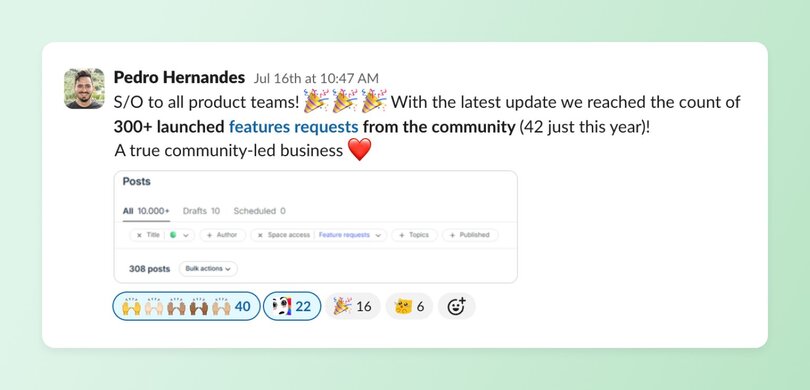
🛠️ Co-creation turns your members into collaborators, not just participants. That’s the kind of feedback loop that keeps people coming back.
5. Create flexible engagement that works on any schedule
Live AMAs or office hours are great ways to encourage engagement, but they’re limited to members whose schedules line up with yours. Offering asynchronous ways to engage with your content and other members can help keep the conversation going, no matter what timezone they’re in.
You can create 24/7 engagement opportunities with:
- Recurring threads. Scheduled threads for things like check-ins, wins of the week, or prompt-based discussions to keep engagement flowing without starting from scratch every time.
- Evergreen content. Timeless resources like FAQs, guides, or onboarding materials that stay relevant and accessible, helping members find value no matter when they join.
- Forum-style replies. Structured, threaded conversations that make it easy to follow discussions, add depth over time, and create a searchable knowledge base your community can build on.
- Content libraries: Whether event recordings, lessons and guidebooks, or just themed content spaces, like Circle does with our Resource library space, can help people build knowledge over time.
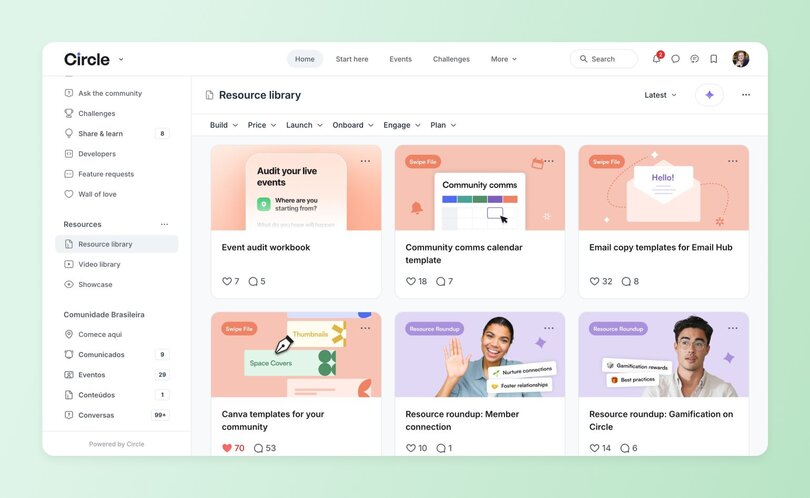
With Circle, members can jump in when it works for them, without the pressure to be “always on.” That’s where async tools come in:
- Courses: Structured, self-paced learning paths that help members build skills, onboard faster, or deepen their knowledge.
- Spaces: Rooms with a purpose. Spaces are customizable areas within your community where members can engage around specific topics, groups, or formats.
- Comments: Lightweight, real-time conversations that keep engagement flowing across posts, events, and content.
📬 Scale engagement on your members’ terms, not just your calendar.
6. Use automation to stay personal at scale
You want to create personal experiences, but doing it all manually can lead to burnout, quickly. That’s where automation steps in. This is more than blasting out messages. It’s automating key moments to create smarter, more intentional rhythms.
Circle lets you automate key moments with workflows, direct messages, AI agents, gamification, and AI workflows, including:
- Onboarding: Onboard new members automatically with personalized welcome messages, profile prompts, and guided first steps
- Follow-ups and reminders: Send timely reminders for events, course progress, or important community updates—based on member behaviour, not just dates
- Milestones: Celebrate milestones like first posts, course completions, or anniversaries to reinforce progress and keep members engaged
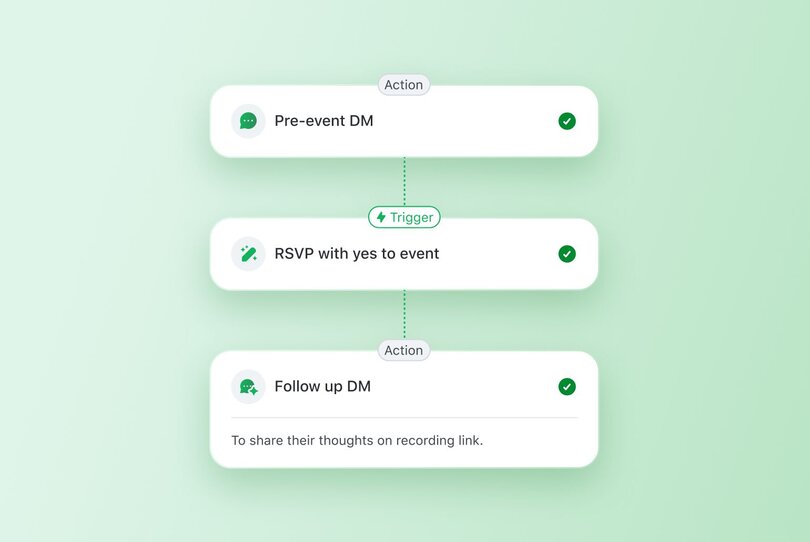
By tying automation to behaviour, you can show up when it matters most and make it feel like you’re always one step ahead.
🤖 It’s not robotic—it’s human at scale.
7. Track engagement with metrics that go beyond clicks
Clicks are easy to track, but they rarely tell you who’s thriving in your community. To truly understand real engagement, you need more effective metrics.
With Circle, you can monitor insights that reveal how connected your members feel and how often they’re showing up for each other:
- Retention: When members keep coming back (or graduating to higher offers, opting into upsells, etc), it means they’re finding real value in what you’ve built.
- Reply rates: When members respond to each other, it shows your community isn’t just active—it’s alive.
- Daily Active and Monthly Active Users (DAU/MAU): This ratio shows how often members engage over time. Higher numbers = stronger stickiness and healthier habits.
- Activation milestones: Track when members hit key moments (like introducing themselves or completing onboarding) to spot what’s working and where to improve.
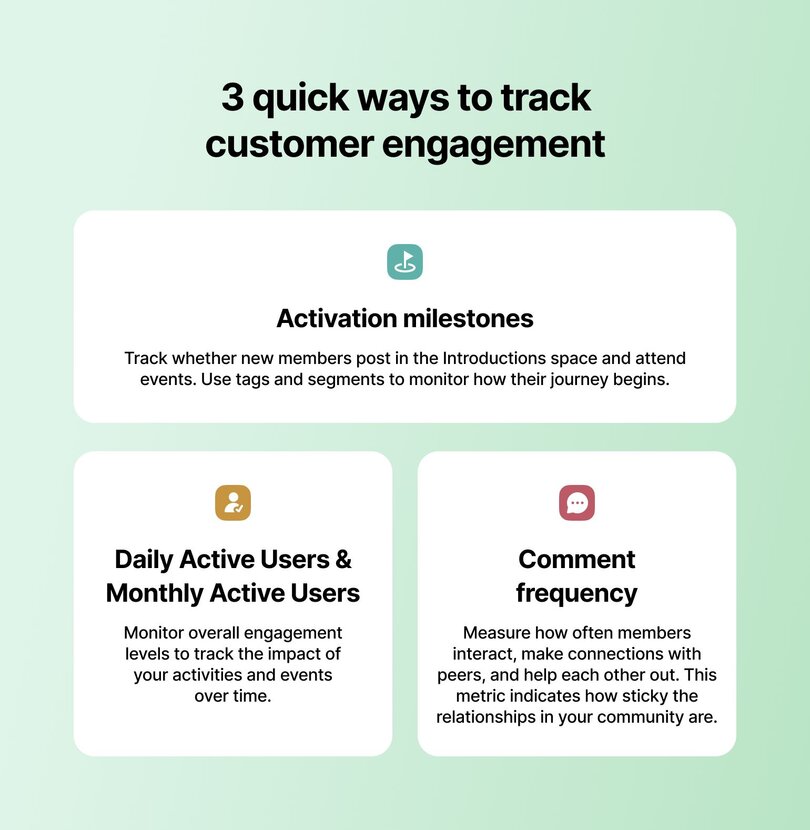
These aren’t vanity metrics. They’re health checks for your community that help you double down on what’s working.
📊 Engagement isn’t just louder—it’s stickier. Circle gives you the tools to prove it.
How community builders can align with customer success and marketing
Community managers sit at the intersection of customer experience, support, and growth. This sweet spot makes them uniquely positioned to help customer success and marketing teams work smarter, not harder.
- With Customer Success: Share insights from member discussions to highlight common friction points, product feedback, or support gaps. Use community spaces to scale onboarding, offer peer-to-peer support, and celebrate customer wins, turning your happiest members into advocates.
- With Marketing: Surface authentic stories, testimonials, and user-generated content (UGC) from your community to power campaigns. Collaborate on launches by hosting live events, AMAs, or discussion threads to keep members engaged throughout the funnel.
When community, customer success, and marketing align, you create a connected customer journey that feels personal, valuable, and impossible to ignore.
TL;DR – Engagement is trust reimagined
Engagement isn’t a one-and-done moment. It’s part of a flywheel that drives member growth and retention.
How? When members find value, they participate. That participation builds trust. Trust leads to referrals. Referrals drive retention. And the loop keeps spinning.
👉🏼 Circle gives you the infrastructure to fuel that flywheel at scale, so you’re not chasing engagement. You’re designing for it.
FAQs
What is a customer engagement strategy?
A customer engagement strategy is your plan for fostering meaningful and consistent interactions with customers. It can include personalized messaging, loyalty programs, events, and more.
One of the most effective approaches is building customer communities, where people can share feedback, perspectives, and connect with one another.
How can small businesses improve customer engagement?
Start with small, intentional actions. Welcome new customers personally, ask for feedback regularly, and create spaces—like a community or private group—where they can connect with you and each other.
What is the role of community in customer engagement?
Community turns engagement from a one-to-one effort into a many-to-many experience. It gives your customers a place to ask each other questions, share ideas, and build relationships that deepen their connection to your brand, without needing you in the room 24/7.
How do I measure customer engagement for an online business?
Don’t just track vanity metrics like open rates and clicks. Look at reply rates, repeat logins, event participation, and how often customers engage with others. For communities, metrics like DAU/MAU, post replies, and course completions show real involvement.
Why are traditional engagement metrics no longer enough?
Traditional metrics track attention, not connection. A click doesn’t tell you if someone found value, or if they’re coming back.
Today, engagement is about participation, retention, and whether customers are contributing to and growing with your brand.
What tools help scale community engagement without losing the human touch?
Look for tools that combine automation with personalization.
Platforms like Circle let you set up onboarding journeys, auto-tag members by behaviour, and automate reminders, all while keeping the experience thoughtful and human, not spammy.